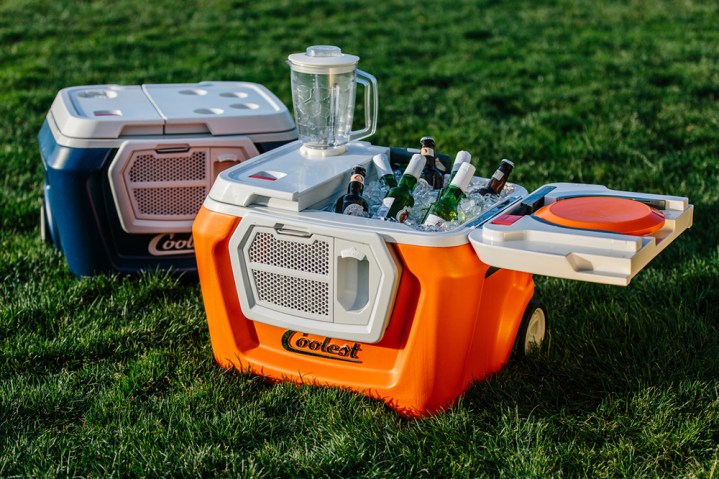
In the world of crowdfunding, there’s no such thing as a sure thing.
Kickstarter and Indiegogo may look and feel like online stores, but unfortunately there’s no guarantee that you’ll get something in return for the money you pledge to a campaign. Most crowdfunding platforms only require that creators make a “good faith effort” to deliver on their promises. That means they face no consequences (aside from angry backers and some bad press) if the project misses its delivery date — or even fails entirely.
To make matters worse, there are a million things that can go wrong between the successful funding of a campaign and the delivery of the final product to your doorstep. The creator could underestimate the amount of funding they need to finish the project. Manufacturing issues could cause long delays. Hell, sometimes projects fail because creators get too much funding, and don’t know how to scale their production processes and fulfill an unexpectedly large volume of orders. Oftentimes, it’s not that the creator was intentionally trying to scam everyone — it’s just that despite their best efforts, something went wrong.

For these reasons, backing a crowdfunding project always involves some level of risk. If you understand the common causes of crowdfunding failures and delays, however, you can make smarter choices about the projects you pledge to support — and still get an awesome deal on that self-balancing electric scooter with laser headlights.
How to avoid getting burned
Over the years, I’ve backed dozens of different Kickstarter projects — but not a single one has failed to deliver. I attribute this long history of not getting screwed over to two things: a dash of luck and a heaping helping of careful consideration. Before I pledge support to a project, I look at a range of different things to determine if the project is likely to be successful. To help you out, I’ve arranged these tips into a handy checklist that you can easily remember with the mnemonic “CRACK.”
While there’s still no guarantee that you won’t get burned, the CRACK method will help you spot red flags and decrease your chances of getting left empty-handed (and empty-pocketed).
C: Consider complexity
Some ideas are easier to bring to life than others. A machined titanium bottle opener, for example, requires only a simple CAD design and enough money to cover materials cost, machining, and shipping. Any issues with the design or manufacturing process could likely be resolved in a couple days, and wouldn’t require large sums of money to fix.
Keep an eye out for real photos of the actual product. If all you see are renderings, that’s a red flag.
A robot that plays fetch with your dog, however, is much more complex to create. In addition to sophisticated hardware, such a robot would also require custom software, which the creators have to write, test, and debug before they can ship the product. Furthermore, this hypothetical robot would likely have lots of custom parts. If the creators encounter manufacturing problems with any of these parts, the whole project will likely be delayed.
Simply put, the more complex the project, the higher the possibility of failure. The only problem with this strategy, of course, is that more complex crowdfunding projects are often the most enticing. If you absolutely must consider backing a project that combines hardware, software, and other components that are tricky to manufacture, make sure that the creator has developed a functional prototype. If the project is merely at the conceptual stage, there’s a high likelihood that it will take a long time to see through to completion. Keep an eye out for real photographs of the actual product. If all you see are renderings, that should be a red flag.
*Pro tip: Keep an eye out for “Hardware Studio” badges on Kickstarter projects. These signify that the creator has entered Kickstarter’s hardware accelerator/ manufacturing mentorship program, and therefore has a higher likelihood of succeeding.
R: Research the creators
This should go without saying, but if you’re going to give someone money, you should know who you’re supporting. Click on their profile. Google their name. Look for their accounts on LinkedIn and Facebook, and try to find professional profiles on their personal or corporate websites. If you can’t find any information about them online, and they don’t link to personal or company profiles on the campaign page, then you should be wary of forking over your hard-earned cash to them.
This is important for two reasons. First of all, a creator’s presence or lack of transparency says a lot. If a person (or group) isn’t willing to show their face and expose their identity to potential backers, the project is — as a rule — sketchy. If the creator remains anonymous, their reputation isn’t at stake if the project fails to deliver, and they could screw backers over without suffering any repercussions. Conversely, if the creator provides personal information and photo of themself, it shows that they’re confident enough in their idea to put their reputation on the line. That’s a good sign.
Second, knowing the creator’s background will help you judge their competency and gauge their fitness to complete the project. Let’s say you’re considering pledging money to a Kickstarter campaign that’s promising an amazing new sleeping bag. If the creator is a burgeoning outdoor gear company that’s independently funded, the project probably has a good chance of delivering. If it’s a random dude who sewed together a prototype in his garage, you might want to think twice about pledging — or at the very least, dial back your delivery date expectations.
You don’t need to stalk the person, but taking 10 minutes to look into their background, experience, and areas of expertise should always be on your pre-pledge checklist. Which brings us to our next step:
A: Analyze their background
After you’ve examined the creator specifically, you should turn your attention to their past achievements. Again, this will help you determine not only if the creator is capable of completing the project, but also how likely they are to complete it on time.
If the creator doesn’t have a track record of product development and delivery, approach with caution.
If the creator has product development experience, and has successfully manufactured something before, there’s a higher likelihood they’ll be able to deliver on a new project. Bonus points if they’ve built something similar to what they’re promising in return for your pledge. Extra bonus points if they’ve produced large volumes of said products, and have experience manufacturing at scale.
If the creator doesn’t have a track record of successful product development and delivery, you should approach with caution. We’re not saying you shouldn’t back the project (giving young startups/inventors/entrepreneurs a chance to prove themselves is a fundamental part of crowdfunding!), but if you do, be prepared for potential delays. If a creator hasn’t completed a similar project before, chances are good that they’ll run into hiccups somewhere along the line. Nothing ever goes perfectly.
For these reasons, second-generation projects are usually no-brainers to back — i.e., projects in which the creator successfully delivered a product to backers, and has returned to Kickstarter to raise funds for the production of a new-and-improved version. It generally means that the creator has already ironed out all the first generation’s design problems, and knows exactly what needs to happen for a successful manufacturing run. These are the projects you can toss money at with confidence — but that doesn’t mean you should pledge support and then never check back.
C: Check the comments
Most crowdfunding platforms provide some sort of comments section where backers can chime in with questions and get direct feedback from the project’s creators — often on a public forum that everyone can see. If you’re thinking of backing a project, these comment threads are a great resource that can provide tons of insight.
For starters, the comment section can help you gauge how responsive the creators are. If there are tons of questions on the page and the creator hasn’t answered any, that’s a bad sign. If, however, the creator responds to most questions within a couple days, and doesn’t provide evasive answers, then they’re probably not out to scam everyone.
On top of that, commenters often spot potential issues that you yourself never would have thought to inquire about. I’ve encountered numerous campaigns that make sensational (and extremely enticing) claims about a product — and then, after checking the comments, I discover that those claims have been thoroughly debunked by somebody who spent hours researching the project independently.
Sure, sometimes the comments are uninformed, inarticulate, and totally alarmist (there’s almost always a guy who type-screams “FRAUD!” and threatens class-action lawsuits after the shipping date gets pushed back two months), but those are the exception, not the rule.
Don’t just check once, either. A campaign’s comments are a resource that’s available throughout the entire lifecycle of a crowdfunding project. Which brings us to the final point on our checklist:
K: Keep an eye on it
Pledging your money is only the beginning. Your journey doesn’t stop there, and you definitely shouldn’t just sit back, relax, and do nothing until a package arrives at your door (or doesn’t). Any problems that the creator might encounter will most likely pop up during tooling, manufacturing, or delivery — all of which generally happen after the campaign meets its funding goal and gets a “successful” badge slapped on it. As such, it behooves you to keep an eye on the project’s progress throughout the entire process.
You definitely shouldn’t just sit back, relax, and do nothing until a package arrives at your door (or doesn’t).
Luckily, most creators are relatively active when it comes to issuing updates and sending out newsletters about their progress. After all, backers have given them the means to chase their dream, so the majority are very good about communication. If they aren’t, however, you should be proactive about checking up on things periodically. Visit the campaign page, check for updates, and take another peek at the comments.
If the creators have gone silent, reach out to them and politely ask for a status update. No response? Hope for the best and prepare for the worst. At best, they’re having trouble and there will be delays. At worst, the project has suffered a critical setback and is spiraling toward failure. If at any point you feel like the project you backed is headed in that direction, get in touch and ask for a refund. There’s no guarantee you’ll get one, but in any case, it’s best to ask before the creator burns through all the pledge money completely.
That’s not to say you should only check up on a project if you get the impression it’s floundering. Even if the project appears to be headed in the right direction, you should still keep an eye on it. More specifically, it’s usually a good idea to circle back and check out the comments section after shipping has commenced and the product has been delivered to the earliest backers (assuming you backed a project that offers a tangible reward). If the final product is substandard or significantly different than what the creators promised, then other backers will usually sound off in the comments section. If you’re diligent, you might be able to request a refund before your package ships.





